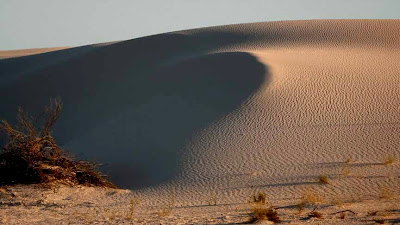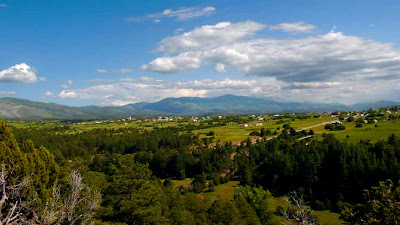 The impressive New Mexico Space Museum along with outdoor exhibits and an Imax theater stands alone high in the foothills above the city of Alamogordo, NM
The impressive New Mexico Space Museum along with outdoor exhibits and an Imax theater stands alone high in the foothills above the city of Alamogordo, NM The International Space Hall of Fame shows pictures and gives a bio of all the men and women from Greek times down through the ages to the present who have made important contributions to astronomy and space exploration.
The International Space Hall of Fame shows pictures and gives a bio of all the men and women from Greek times down through the ages to the present who have made important contributions to astronomy and space exploration.Standing on its pad at the New Mexico Museum of Space History, Little Joe II, powered by up to nine rocket motors with a combined thrust of 860,000 pounds, is, symbolically, ready to go. The solid-fueled Little Joe flew from White Sands Missile Range between August 1963 and January 1966 to develop and test launch escape systems. During an in-flight “emergency”, the Launch Escape System fired and pulled the Apollo Command Module containing the astronauts safely away from the booster. These rocket motors used in the Apollo and Saturn rockets were the kind of solid-fuel motors that United Technologies developed and tested in Sunnyvale and San Jose and which I photographed with extremely high speed cameras when I worked there in the early 1980s. Only, when we tested them, we always pointed the rocket down into the ground!
 The F-1, a very complex liquid-fuel rocket engine to provide
The F-1, a very complex liquid-fuel rocket engine to providethe very large thrust needed to get a payload into orbit
The 18 feet tall F-1 rocket engine is the most powerful single chamber, liquid-fuel rocket engine ever flown. It had a thrust of over 1,500,000 pounds—compare that to the Little Joe engines. Five of these engines were clustered to power the first stage of the Saturn V rocket which carried men to the moon. (Remember 1969 and Neil Armstrong.) One of the big problems in the early days was the transition from the liquid-fueled first stage to the solid-fueled later stages.
Meteorites were once thought to pose a significant danger to spacecraft and their crews. To test their effects NASA launched the Meteoroid Technology Satellite (MTS) from Wallops Island in 1972. The satellite gathered information on meteoroid speeds, quantities, and penetration rates. Results indicated meteoroids are not a serious hazard to spacecraft.
The Space Museum is not very contemporary, but it does give a good perspective on the development of understanding and technology needed to land a man on the Moon. The staff is skilled at helping teachers shepherd their bus loads of school children down the ramps of the five story building.
WHITE SANDS NATIONAL MONUMENT

The white sand in White Sands National Monument is not your ordinary garden-variety of silica from white granite. It is composed of white gypsum (a form of hydrous calcium sulfate (CaSO4•2H2O)—one of its main uses is to make plaster board to make walls in our homes.) It occurs in the form of sand only a few places in the World because it is soluble in water. The Monument is by far the largest such gypsum dune field.
In the early 1930s, the National Monument was carved out of the middle of the White Sands Missile Range which is involved in testing NASA rockets and space gear as described above. The Missile Range has the distinction of being the site of one of the most important scientific experiments ever conducted. It was here at the so-called Trinity Site that proof that mass could be converted into energy on a large scale (in this case in the form of an explosion) at the detonation of the first atomic bomb at 5:30 a.m. on July 16, 1945. And thus we entered into the Atomic Age—with its bombs, electrical power generation, and emphasis on atomic reactions. (And incidentally, a technology that saved millions of lives, both American and Japanese by terminating World War II.)
The Dune Nature Trail is one of several trails through the dunes, although you can see a lot from the 16 mile (round trip) scenic auto drive through the dunes.
It’s kind of interesting how explosions have provided a leap of technology over the ages: black powder and guns, nitroglycerine (in the form of dynamite) and construction, gasoline or diesel and transportation, popcorn and the end of sticky sweets with movies, atom and hydrogen bombs and the release of the energy of the atom, kerosene and oxygen and space exploration, hydrogen and oxygen and the fuel cell…
I made one trip to White Sands Missile Range to photograph rocket motors in action while working for United Technologies.
 The dunes are eerie—so brilliant (I think brighter than snow) with ripples having blue shadows. There are white plants with hugh root systems like this Poliomintha incana, white lizards, and weird sunsets. I used the snow setting on my camera bracketing over a two stop range, but of course, the actual range of up to 10 stops can’t be totally recorded that way (if I were more adept at it, RAW would have been the way to go); but good old Photoshop and its Highlight and Shadow filter saved the day.
The dunes are eerie—so brilliant (I think brighter than snow) with ripples having blue shadows. There are white plants with hugh root systems like this Poliomintha incana, white lizards, and weird sunsets. I used the snow setting on my camera bracketing over a two stop range, but of course, the actual range of up to 10 stops can’t be totally recorded that way (if I were more adept at it, RAW would have been the way to go); but good old Photoshop and its Highlight and Shadow filter saved the day.At the Golden Hour the photographers all come out and stay through the main attraction of the day: sunset. In this case, they are perched on top of all the large dunes with their tripoded cameras at ready. At 7 p.m., even though sunset is almost an hour and a half away, the family groups are gathered around their picnic basket for a cold dinner, each king on his own mountain; the young adults shouting across the valleys to each other.
But as the light exhibits more than a tinge of red, you feel the otherworldliness of these strange glowing, rosy dunes…
 White-on-white with red highlights—
White-on-white with red highlights—Jean waits in the white Dream Machine in a field of white with sunset color creeping up the near-by dune.
And now for the bizarre phenomenon of the blazing sunset. The sun seems to develop concentric rings and the sky turns shades of green to orange, while the back side of the mountains becomes vermillion. Only the dunes take on a color you would expect, though the blue in the shadows seems exaggerated.
Allow me to close the story of White Sands with a quotation from Laurent Martrès, “White Sands National Monument is a place of exceptional beauty. The fantastic white gypsum, exotic-looking yuccas, and beautiful ripple patterns in the sand all contribute to a truly unique experience, unlike any other dune system.”
Anatomy of a Blog (or How I give birth to a blog.)
Because of my interest and orientation, my order is: pick the picture, then compose the prose (often from signs on the spot, brochures or guides, or books such as our favorite, so far this trip, Photographing the Southwest by Laurent Martrès—the notable omission is the use of the internet, since we have access to it only a sporadically.).Since, between us, Jean and I produce two or three hundred shots a day, there usually no problem about finding a few good photos. I work on the seven to ten mega-pixel image to make it more than just a record shot or a postcard view. Finally, after one to three hours work on a picture, I select its size (what you get when you click on the picture in the blog), usually 10 or 12 inches (I found looking at other people’s computer monitors with other internet connections that they weren’t able to see all the picture at once if I made the dimension larger than 12”.).
And then comes the very painful part: I have to reduce the pixels (there goes the quality!) by a factor of somewhere up to 25 so it will fit into the size specified by the company managing the blog (Google, in this case) and will load quickly for those who don’t have super-computers. But if you take a 10 million pixel image and reduce it to less than a half million pixels, you have only a representation of the original!
Then I put together the blog in Apple’s new word processor, called Pages, putting in the pictures and determining their arrangement and size, write the text, and send it to my proofreader and assistant editor, Jean. After she approves or makes some of my exotic or tortuous logic more straightforward and understandable, we go looking for an internet connection.
Next (after finding an internet connection one way or another), I start with Apple’s Safari and transfer the pictures, then text to the new blog. Safari is easier to put stuff into the blog (and I know most of my friends have Macintosh computers). Next I close Safari and open the blog in Firefox (which sort of represents all other browsers) and add font styles and position the pictures more accurately, which Safari doesn’t support. The proofreader checks and makes final suggestions; I go back to Safari to check that nothing is too much out of place, and then — publish!. From the Pages setup to the published blog averages about three hours, although frustrating blogs have taken eight hours when the blog just won’t f0rmat the way I want it.
The blog was the brilliant idea of Jean’s sister and brother-in-law, Marian & Dave Cortesi, who set it up for us, for which we are very grateful (It’s lots more fun than writing postcards.). I am relatively new at this, but I do do enjoy spending my evenings working with images in the computer. I don’t play cards, do jigsaw puzzles, nor read novels, although occasionally I do listen to music and and watch DVDs such as Star Trek or my favorite TV programs which our friend Diane sends me en route.
Jean has a hard time keeping up when we happen upon a massive floral event such as the wild flowers in Big Bend National Park (I’m giving away our next location.). She ends up photographing and identifying day and night ‘til she catches up. That is one reason why her blogs are relatively few and far between.























































